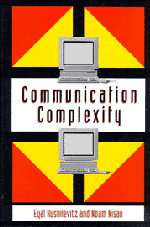Book contents
- Frontmatter
- Contents
- Preface
- I Two-Party Communication Complexity
- II Other Models of Communication
- III Applications
- 8 Networks, Communication, and VLSI
- 9 Decision Trees and Data Structures
- 10 Boolean Circuit Depth
- 11 More Boolean Circuit Lower Bounds
- 12 Time and Space
- 13 Randomness
- 14 Further Topics
- Index of Notation
- A Mathematical Background
- Answers to Selected Problems
- Bibliography
- Index
9 - Decision Trees and Data Structures
Published online by Cambridge University Press: 05 November 2009
- Frontmatter
- Contents
- Preface
- I Two-Party Communication Complexity
- II Other Models of Communication
- III Applications
- 8 Networks, Communication, and VLSI
- 9 Decision Trees and Data Structures
- 10 Boolean Circuit Depth
- 11 More Boolean Circuit Lower Bounds
- 12 Time and Space
- 13 Randomness
- 14 Further Topics
- Index of Notation
- A Mathematical Background
- Answers to Selected Problems
- Bibliography
- Index
Summary
Decision Trees
One of the simplest models of computation is the decision tree model. In this model we are concerned with computing a function f: {0, 1}m → {0, 1} by using queries. Each query is given by specifying a function q on {0, l}m taken from some fixed family Q of allowed queries (the queries need not be Boolean). The answer given for the query is simply the value of q(x1, …, xm). The algorithm is completely adaptive, that is the i-th query asked may depend in an arbitrary manner on the answers received for the first i − 1 queries. The only wayto gain information about the input x is through these queries. The algorithm can therefore be described as a labeled tree, whose nodes are labeled by queries q ∈ Q, the outgoing edges of each node are labeled by the possible values of q(x1, …, xm), and the leaves are labeled by output values. Each sequence of answers describes a path in the tree to a node that is either the next query or the value of the output. In Figure 9.1 a decision tree is shown that computes (on inputs x1, …, x4) whether at least three of the input bits are 1s. It uses a family of queries Q consisting of all disjunctions of input variables and conjunctions of input variables.
The cost measure we are interested in is the number of queries performed on the worst case input; that is, the depth of the tree.
Definition 9.1: The decision tree complexity of a function f using the family of queries Q, denoted TQ(f), is the minimum cost decision tree algorithm over Q for f.
Information
- Type
- Chapter
- Information
- Communication Complexity , pp. 114 - 118Publisher: Cambridge University PressPrint publication year: 1996
